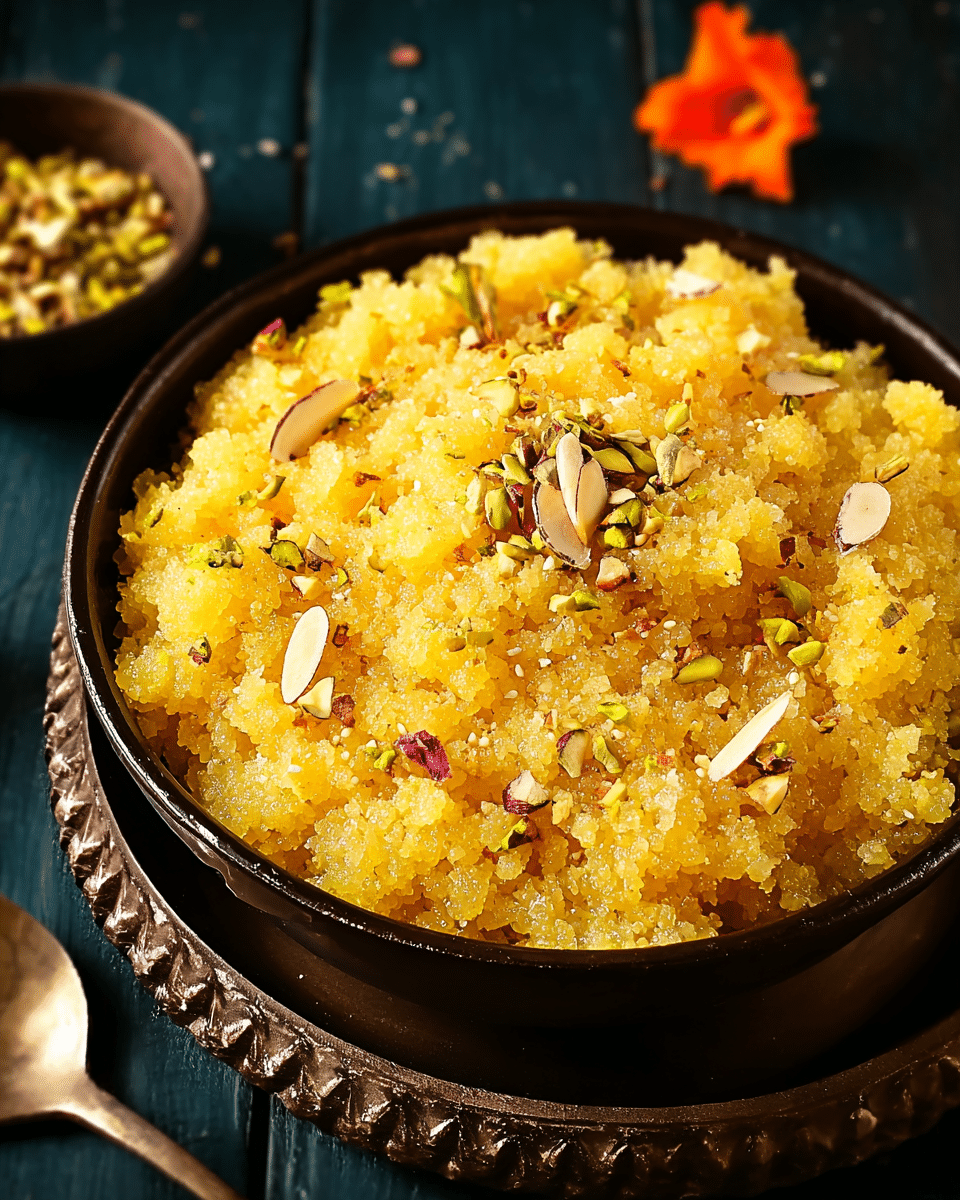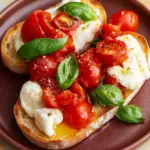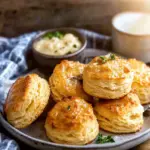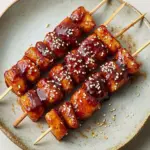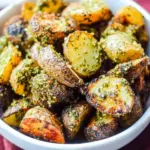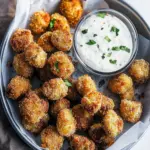The rich heritage of Indian sweets finds one of its finest expressions in Moong Dal Halwa – a slow-roasted dessert crafted from split mung lentils, pure ghee, and fragrant cardamom. A staple at weddings, festivals, and family celebrations, this delicacy is known for its intense flavor, golden hue, and luxurious melt-in-the-mouth texture.
Prepared with patience and love, this halwa starts by grinding soaked dal, frying it to deep golden perfection in aromatic ghee, and finishing with a touch of saffron and sweetener. The garnish of crunchy almonds and pistachios adds texture and contrast, making it a decadent treat that’s as visually stunning as it is soul-satisfying.
Full recipe:
Ingredients:
-
½ cup yellow moong dal (split mung lentils)
-
6 tablespoons ghee (plus 2 tbsp optional)
-
½ tablespoon semolina (suji/rava, optional)
-
½ cup water (room temperature)
-
½ cup milk (room temperature)
-
1 pinch saffron strands (optional)
-
6 to 8 tablespoons sugar (adjust to taste)
-
½ teaspoon cardamom powder or rose water
-
6 almonds, finely chopped (for garnish)
-
6 pistachios, finely chopped (for garnish)
Directions:
-
Rinse moong dal thoroughly and soak it for 30 minutes. Drain completely.
-
Blend soaked dal into a very slightly coarse paste. Do not add much water.
-
Heat ghee in a heavy-bottomed pan. Add semolina and fry for a minute until aromatic.
-
Add the ground dal to the pan and stir constantly over medium heat to incorporate ghee.
-
Continue frying for 10-15 minutes, breaking any lumps until the mixture becomes crumbly and golden.
-
Once it turns aromatic and deep golden, pour in milk and water slowly while stirring. Add saffron if using.
-
Cook until liquid is absorbed. Add sugar and mix well.
-
The mixture becomes gooey and then thickens; add cardamom powder (or rose water) and optional 2 tbsp ghee.
-
Continue stirring until the halwa leaves the sides of the pan.
-
In a separate pan, toast almonds and pistachios. Garnish halwa before serving.
Prep Time: 10 minutes | Cooking Time: 30 minutes | Total Time: 40 minutes
Kcal: 526 kcal | Servings: 2
Cultural Significance and Regional Popularity
While Moong Dal Halwa is cherished across India, it is especially prominent in North Indian states such as Rajasthan, Uttar Pradesh, Punjab, and Delhi. In Rajasthan, where the arid climate encourages the use of ghee and lentils in daily cooking, this halwa takes on a cultural identity of its own. It is a must-have during Marwari weddings and is often made in large quantities to serve guests at grand feasts.
This dessert is also widely served during Hindu festivals like Diwali, Holi, and Navratri. Its richness symbolizes prosperity and celebration, which makes it an ideal offering to deities and a highlight of any festive meal. Over generations, the preparation and sharing of Moong Dal Halwa have become a communal activity, bringing families together and preserving culinary traditions.
Texture, Flavor, and Aromatics
What truly sets Moong Dal Halwa apart from other Indian sweets is its texture—a delicate balance of softness and slight graininess. This unique mouthfeel is achieved by carefully grinding soaked lentils to a slightly coarse consistency and then slow-roasting them in ghee until they turn golden and aromatic. The process demands constant attention, stirring, and adjustment of heat to ensure even cooking without burning.
Flavor-wise, the halwa is deeply nutty with a buttery richness that comes from the generous use of ghee. The addition of cardamom introduces a subtle, floral note that pairs beautifully with the warmth of saffron. Sugar is added at just the right stage to bind everything together and give the halwa its signature sweetness without overpowering the earthiness of the lentils. The final garnish of toasted nuts adds a delightful crunch, creating contrast with the creamy base.
Modern Adaptations and Dietary Notes
As dietary preferences evolve, modern cooks have found ways to adapt Moong Dal Halwa to suit contemporary lifestyles. For instance, some versions reduce the amount of ghee without compromising too much on flavor, especially when using non-stick pans that facilitate easier roasting. Others opt for vegan-friendly alternatives by using plant-based ghee and almond or oat milk in place of dairy milk.
In traditional recipes, mawa (dried milk solids) may also be added towards the end to boost the richness. However, this ingredient is often omitted in modern renditions to reduce cooking time and simplify the process. The dessert is naturally gluten-free and high in protein and fiber due to the moong dal, making it not only delicious but also a satiating treat when enjoyed in moderation.
Despite these adaptations, purists still prefer the age-old technique of slow-cooking with full-fat ghee, believing that the real essence of Moong Dal Halwa lies in the time and patience invested in its making.
Tips for Perfecting the Halwa
Making Moong Dal Halwa requires skill, patience, and a little culinary intuition. One of the most critical aspects is the soaking time. Over-soaking the dal can make it difficult to roast properly, which in turn affects the final texture. Ideally, a 30-minute soak is sufficient to soften the lentils for grinding without making them too soggy.
The choice of cookware also plays a significant role. A heavy-bottomed or cast-iron pan is recommended to ensure even heat distribution and to prevent the mixture from sticking or burning. Consistent stirring is crucial throughout the process, especially after adding sugar and milk when the mixture becomes denser and harder to manipulate.
Another important tip is the quality of ghee. Since ghee is a dominant flavor, using high-quality, aromatic ghee enhances the overall experience of the dish. A final touch of cardamom or rose water at the end of cooking acts as a flavor amplifier, providing that signature Indian dessert note that lingers on the palate.
Pairing and Serving Suggestions
Moong Dal Halwa is best served hot or warm, as that is when its texture and flavor are at their peak. It pairs beautifully with a scoop of vanilla ice cream for a fusion twist or can be served alongside other Indian sweets in a traditional thali. The halwa can also be presented in mini dessert cups or tart shells for a modern party-friendly format.
As a winter dessert, it is particularly comforting due to its warmth and richness, making it ideal for cold evenings or late-night festive meals. The addition of saffron and nuts not only boosts flavor but also gives it a regal presentation suitable for the most elegant dining tables.
Health Considerations and Nutritional Value
While Moong Dal Halwa is undoubtedly rich and indulgent, it does offer some nutritional benefits. Moong dal is an excellent source of plant-based protein, dietary fiber, and essential minerals such as potassium and iron. The lentils are known for being easily digestible and are commonly used in Ayurvedic diets.
However, the high content of ghee and sugar means the halwa is best enjoyed occasionally and in moderation, especially for those watching their calorie or fat intake. Each serving of Moong Dal Halwa can contain upward of 500 kcal, with a significant portion coming from fats. Those looking to enjoy it as a part of a balanced diet may consider smaller portions or substituting with lower-fat ingredients as mentioned earlier.
Traditional vs. Instant Versions
In recent years, many brands and home chefs have developed instant or pre-mixed versions of Moong Dal Halwa to cater to time-pressed individuals. These mixes are often made with pre-roasted dal flour and require only water or milk and a quick cooking process. While convenient, these versions typically lack the depth of flavor and nuanced texture that come from the traditional slow-cooking method.
Nevertheless, for everyday indulgence or last-minute dessert needs, instant versions can offer a satisfying shortcut. Some families even make their own homemade halwa mix in bulk and store it for quick preparations on demand.
Conclusion
Moong Dal Halwa is more than just a dessert—it’s a celebration of Indian culinary heritage, passed down through generations and enriched with love, patience, and tradition. From the first spoonful, it captivates the senses with its golden hue, rich aroma, and velvety texture. Its labor-intensive preparation only enhances its value, making each bite a reward in itself.
Whether enjoyed during festivals, weddings, or cozy winter nights, Moong Dal Halwa remains a symbol of indulgence and festivity. While modern variations continue to emerge, the traditional version stands as a testament to the timeless appeal of Indian sweets. By mastering this classic, one not only savors a beloved dish but also preserves a cherished piece of India’s culinary soul.

